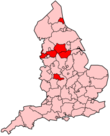- Metropolitan borough
-
For other uses, see Metropolitan borough (disambiguation).
Metropolitan district 
Metropolitan counties shown within EnglandAlso known as Metropolitan borough Category Districts Location England Found in Metropolitan county Created by Local Government Act 1972 Created 1 April 1974 Number 36 (as of 2008) Possible status City Borough District Populations 0.1 - 1.1 million A metropolitan borough is a type of local government district in England, and is a subdivision of a metropolitan county. Created in 1974 by the Local Government Act 1972, metropolitan boroughs are defined in English law as metropolitan districts, however all of them have been granted or regranted royal charters to give them borough status (as well as some with city status).[1] Metropolitan boroughs are effectively unitary authority areas, since the abolition of metropolitan county councils by the Local Government Act 1985.[2]
The term metropolitan borough was also used for administrative subdivisions of London between 1900 and 1965. The present boroughs in London are known as London Boroughs rather than metropolitan boroughs.
The current metropolitan boroughs were created in 1974 as subdivisions of the new metropolitan counties which were created to cover the six largest urban areas in England outside Greater London. The new districts replaced the previous system of county boroughs, municipal boroughs, urban and rural districts. The districts typically have populations of 174,000 to 1.1 million.
Metropolitan districts were originally part of a two-tier structure of local government, and shared power with the metropolitan county councils (MCCs). They differed from non-metropolitan districts, in the division of powers between district and county councils. Metropolitan districts were Local Education Authorities and were responsible for social services and libraries; in non-metropolitan counties these services were the responsibility of county councils.[3]
In 1986 the metropolitan county councils were abolished by the Local Government Act 1985 and most of their functions were devolved to the boroughs, making them to a large extent unitary authorities. Some of the functions of the abolished county councils were taken over by joint bodies such as passenger transport authorities, and joint fire, police and waste disposal authorities.[2]
The 36 metropolitan boroughs are:
Metropolitan county Metropolitan districts Number County population Greater Manchester Manchester, Bolton, Bury, Oldham, Rochdale, Salford, Stockport, Tameside, Trafford, Wigan 10 2,573,200 Merseyside Liverpool, Knowsley, St Helens, Sefton, Wirral 5 1,365,000 South Yorkshire Sheffield, Barnsley, Doncaster, Rotherham 4 1,290,000 Tyne and Wear Newcastle upon Tyne, Gateshead, South Tyneside, North Tyneside, Sunderland 5 1,089,400 West Midlands Birmingham, Coventry, Dudley, Sandwell, Solihull, Walsall, Wolverhampton 7 2,591,300 West Yorkshire Leeds, Bradford, Calderdale, Kirklees, Wakefield 5 2,161,200 References
See also
- Metropolitan boroughs of the County of London
- Borough
- Non-metropolitan district
- County borough
- Subdivisions of England
- ISO 3166-2:GB, subdivision codes for the United Kingdom
- Political make-up of Metropolitan borough councils
 Subdivisions of England
Subdivisions of EnglandRegion County District Metropolitan • Non-metropolitan • London borough • City of London • Unitary authority • Isles of ScillyCivil parish Borough status in the United Kingdom Contemporary London borough · Metropolitan borough (England)Municipal borough Municipal Corporations Act 1835 (1835–1882 incorporations) · Municipal Corporations Act 1882 (1882–1974 incorporations) · County borough · Metropolitan borough (London) · Local Government Act 1933 · Rural boroughAncient borough Unreformed boroughs 1835–1886Metropolitan counties and metropolitan districts Greater Manchester 
Merseyside South Yorkshire Tyne and Wear West Midlands West Yorkshire Categories:- Metropolitan boroughs
- Interested parties in planning in the United Kingdom
- Types of subdivision in the United Kingdom
- Boroughs of the United Kingdom
Wikimedia Foundation. 2010.

